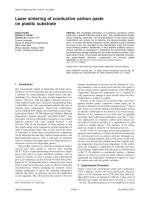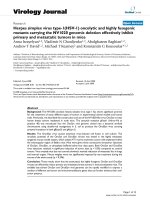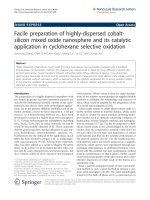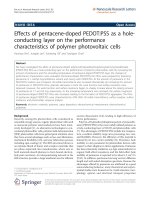Highly conductive poly(3,4 ethylenedioxythiophene) poly (styr enesulfonate) (pedot PSS) films and their application in polymer photovoltaic devices
Bạn đang xem bản rút gọn của tài liệu. Xem và tải ngay bản đầy đủ của tài liệu tại đây (3.98 MB, 172 trang )
HIGHLY CONDUCTIVE
POLY(3,4-ETHYLENEDIOXYTHIOPHENE):POLY(STYR
ENESULFONATE) (PEDOT:PSS) FILMS AND THEIR
APPLICATION IN POLYMER PHOTOVOLTAIC
DEVICES
XIA YIJIE
NATIONAL UNIVERSITY OF SINGAPORE
2011
HIGHLY CONDUCTIVE
POLY(3,4-ETHYLENEDIOXYTHIOPHENE):POLY(STYR
ENESULFONATE) (PEDOT:PSS) FILMS AND THEIR
APPLICATION IN POLYMER PHOTOVOLTAIC
DEVICES
XIAYIJIE
(M. Sci, Fudan Univ.)
A THESIS SUBMITTED
FOR THE DEGREE OF DOCTOR OF PHILOSOPHY
DEPARTMENT OF MATERIALS SCIENCE &
ENGINEERING
NATIONAL UNIVERSITY OF SINGAPORE
2011
i
Acknowledgements
My deepest gratitude goes first and foremost to Assistant Professor Ouyang
Jianyong, my supervisor, for his invaluable guidance and encouragement during my
candidature. Due to his abundant academic experience and insightful intuition,
discussing with him has always brought about refreshing ideas. It was extremely
pleasant to be working with him. Over the years, I have benefited tremendously from
his emphasis on critical thinking and encouragements to innovate. His keen and
vigorous academic observation enlightens me not only in this thesis but also in my
future study.
I will always appreciate the friendship and support of my group members.
Special thanks go to Dr. Zhang Hongmei for her great efforts in the polymer
photovoltaic devices fabrication. She helped and taught me how to fabricate and
characterize polymer photovoltaic devices and generously shared tips on the design
and conduction of experiments. I would like to extend my thanks to other group
members: Dr. Wu Zhonglian, Mr. Fan Benhu, Dr. Li Aiyuan, Dr. Zhou Dan, Mr. Mei
Xiaoguang, Mr. Sun Kuan, Ms. Cho Swee Jen and Mr. Neo Chin Yong. Their
invaluable suggestions, persistent research assistance and unfailing support are
important to my research.
ii
I would like to thank to our department staffs. They have always been helpful,
providing trainings and guidance for utilizing the technical facilities.
Finally, I am deeply indebted to my parents for their unconditional love and to
my husband for his endless support and loving care.
December 2010 in Singapore Xia Yijie
iii
Table of Contents
Acknowledgements i
Table of Contents iii
Summary v
List of Tables viii
List of Figures ix
List of Publications xvii
Chapter 1 Introduction 1
1.1 A brief overview of conducting polymers 1
1.1.1 Historical background of conducting polymers 1
1.1.2 Electrical properties of conducting polymers 4
1.2 Background and development of PEDOT:PSS 10
1.2.1 Background of PEDOT:PSS 10
1.2.2 Charge transport properties of PEDOT:PSS 12
1.2.3 Development of PEDOT:PSS 13
1.3 Applications for PEDOT:PSS in polymer photovoltaic devices 15
1.4 Objectives and outline of this thesis 19
Chapter 2 Salt-induced significant conductivity enhancement of PEDOT:PSS
films 22
2.1 Introduction 22
2.2 Experimental procedure 23
2.3 Results and discussion 26
2.3.1 Metal ion effect on conductivity enhancement 26
2.3.2 Anion effect on conductivity enhancement 43
2.3.3 Application of highly conductive PEDOT:PSS in polymer PVs 58
2.4 Conclusions 61
iv
Chapter 3 Highly conductive PEDOT:PSS films prepared through a treatment
with zwitterions 63
3.1 Introduction 63
3.2 Experimental procedure 64
3.3 Results and discussion 65
3.3.1 Zwitterion-induced conductivity enhancement of PEDOT:PSS films .65
3.3.2 Mechanism for zwitterion-induced conductivity enhancement 69
3.3.3 Application of highly conductive PEDOT:PSS in polymer PVs 77
3.5 Conclusions 82
Chapter 4 Significant conductivity enhancement of PEDOT:PSS films through
a treatment with organic carboxylic acids and inorganic acids 84
4.1 Introduction 84
4.2 Experimental procedure 85
4.3 Results and discussion 86
4.3.1 Conductivity enhancement of PEDOT:PSS by acid treatment 86
4.3.2 Mechanism for conductivity enhancement 103
4.3.3 Application of highly conductive PEDOT:PSS in polymer PVs 108
4.4 Conclusions 111
Chapter 5 PEDOT:PSS films with high conductivities induced by preferential
solvation with cosolvents 112
5.1 Introduction 112
5.2 Experimental procedure 113
5.3 Results and discussion 114
5.3.1 Cosolvent-induced conductivity enhancement of PEDOT:PSS films 114
5.3.2 Characterization of PEDOT:PSS films 122
5.3.3 Mechanism for cosolvent-induced conductivity enhancement 129
5.3.4 Application of high-conductivity PEDOT:PSS in polymer PVs 136
5.4 Conclusions 139
Chapter 6 Concluding remarks 140
6.1 Summary of results 140
6.2 Future work 143
Bibliography 145
v
Summary
New transparent conductive materials are urgently needed to replace indium tin oxide
(ITO) as the transparent electrode of optoelectronic devices.
Poly(3,4-ethylenedioxythiophene):poly(styrenesulfonate) (PEDOT:PSS) is a quite
promising candidate as the next-generation transparent electrode in optoelectronic
devices. However, as-prepared PEDOT:PSS from its aqueous solution suffers a
problem of low conductivity of <1 S/cm. It is important to significant enhance the
conductivity of PEDOT:PSS. This study aims at developing novel and effective
methods to achieve highly conductive PEDOT:PSS films, understanding the
mechanism for the conductivity enhancement, and demonstrating the application of
these highly conductive PEDOT:PSS films as the transparent electrode of polymer
photovoltaic cells (PVs).
Four novel methods have been developed to significantly enhance the
conductivity of PEDOT:PSS in this study. The first approach is to significantly
enhance the conductivity of PEDOT:PSS films through a treatment with solution of a
certain salt. Conductivity enhancement by a factor of about 1000 was observed. The
conductivity enhancement depended on the softness parameter of cations and the
concentration of the salts in solution. The anions of the salts can also affect the
vi
salt-induced conductivity enhancement of the PEDOT:PSS film. The mechanism for
the conductivity enhancement was studied by various characterizations. It is attributed
to the PSSH loss from the PEDOT:PSS film and the conformational change of
PEDOT chains resulted from the salt-induced charge screening between PEDOT and
PSS.
In order to avoid metal ion in PEDOT:PSS that can diffuse into the active layer
of organic electronic devices and deteriorate the devices, zwitterions were used to
replace the salts in the first method to treat the PEDOT:PSS film. The conductivity of
PEDOT:PSS films could be significantly enhanced to close to 100 S/cm through a
treatment with aqueous solution of a zwitterion. The zwitterions can effectively
induce a charge screening between PEDOT and PSS and consequently lead to the
significant conductivity enhancement, while their large size and Coulombic
interactions make the ion diffusionin the PEDOT:PSS films difficult. Polymer PVs
with the zwitterion-treated PEDOT:PSS films as the transparent electrode were
demonstrated, and the photovoltaic efficiency as high as 2.48% was achieved under
AM 1.5G illumination.
The third way is to significantly enhance the conductivity of PEDOT:PSS by
carboxylic acids and inorganic acids. The conductivity of the PEDOT:PSS film could
be enhanced to over 200 S/cm, that is, by a factor of more than 1000. The
conductivity enhancement is attributed to acid-assisted PSSH loss from the
PEDOT:PSS film and conformational change of the PEDOT chains. Polymer PVs
with the acid-treated PEDOT:PSS films as the transparent electrode were
vii
demonstrated and the photovoltaic efficiency as high as 2.53% was achieved.
The forth method is to treat PEDOT:PSS films with cosolvents of water and
common organic solvents like ethanol, acetone, isopropyl alcohol, and
tetrahydrofuran (THF). Conductivity enhancement from 0.2 S/cm to 103 S/cm was
observed. The conductivity enhancement is attributed to the preferential solvation of
PEDOT:PSS by the cosolvents. The preferential solvation induces the departure of the
insulator PSSH chains from the PEDOT:PSS film, aggregation of PSSH segments in
the PEDOT:PSS film, and the conformational change of the PEDOT chains from
coiled to linear. The cosolvent-treated PEDOT:PSS films were quite smooth. They
were used as the transparent electrode of polymer PVs. Photovoltaic efficiency close
to 3% was achieved.
viii
List of Tables
Table 2.1 Conductivity of PEDOT:PSS films after treated with 0.1 M
solutions of various salts 36
Table 2.2 Conductivities of PEDOT:PSS films after a treatment with 0.1 M
and 1 M aqueous solutions of various salts 44
Table 2.3 Photovoltaic performances of polymer PVs with salt-treated or
untreated PEDOT:PSS films as the anode 59
Table 3.1 Photovoltaic performances of polymer PVs with zwitterion- or
salt-treated PEDOT:PSS films as the anode 79
Table 4.1 pK
a
and physical parameters of acids used in this study 89
Table 4.2 Photovoltaic performances of polymer PVs with acid-treated
PEDOT:PSS films as the anode
110
Table 5.1 Chemical structure and physical properties of organic solvents and
conductivities of PEDOT:PSS films treated with cosolvents and neat solvents. 117
Table 5.2 Photovoltaic parameters and efficiencies of polymer PVs with
untreated and cosolvent-treated PEDOT:PSS films as the anode
139
Table 6.1 Conductivities of the PEDOT:PSS films treated with four methods
and PCE value of the devices using these PEDOT:PSS films as anode
143
ix
List of Figures
Figure 1.1 Oxidative and reductive doping of PA 3
Figure 1.2 Chemical structures of some well-known conducting polymers 3
Figure 1.3 Conductivities of conducting polymers and other materials,
reproduced from [9] 5
Figure 1.4 Illustration and electronic states of soliton in PA, adapted from
[12,13] 6
Figure 1.5 Illustration and electronic states of polaron in polypyrrole, adapted
from [12,13] 7
Figure 1.6 Illustration and electronic states of bipolaron in polypyrrole,
adapted from [12,13] 8
Figure 1.7 Optical absorption spectra of ClO
4
-doped polypyrrole as a function
of dopant concentration, The dopant level increases from the bottom curve
(almost neutral polypyrrole) to the top curve (33 mol% doping level),
reproduced from [13] 9
Figure 1.8 The schematic picture of the morphology of PEDOT:PSS and its
chemistry structure. Left: the top view of the morphology of a thin film of
PEDOT:PSS particles, surrounded by a thin PSS-rich surface layer. PEDOT
chains are displayed as short bars. Right: chemical structure of the species
present in the film, reproduced from [17] 10
x
Figure 1.9 Schematic image of PEDOT:PSS chain: a long PSS chain with
PEDOT oligomeric chains, reproduced from [3] 12
Figure 1.10 Schematic illustration of a polymer PV device, with a magnified
area showing the bicontinuous morphology of the active layer, reproduced
from [56] 16
Figure 1.11 The typical current-voltage characteristics for dark and light
current in a polymer PV illustrate the important parameters for such devices,
reproduced from [56] 16
Figure 2.1 Schematic structure of P3HT and PCBM 25
Figure 2.2 Variation of the conductivity of treated PEDOT:PSS films with
CuCl
2
concentration. The inset plots the same data with the CuCl
2
concentration in logarithmic scale. The straight line in the inset is the linear
fitting of the data 27
Figure 2.3 Dependence of the conductivity of treated PEDOT:PSS films on
treating temperature. The solution is 0.074 M CuCl
2
aqueous solution 28
Figure 2.4 UV-Visible-NIR absorbance spectra of PEDOT:PSS films before
(solid curve) and after the treatment with 0.1 M MgCl
2
(dashed dotted curve),
0.1 M NaCl (dotted curve), and 0.1 M CuCl
2
(dashed curve) solution 29
Figure 2.5 S
2p
XPS spectra of untreated PEDOT:PSS (solid curve) and
PEDOT:PSS treated with 0.37 M CuCl
2
solution (dashed curve) 30
Figure 2.6 FTIR spectra of untreated PEDOT:PSS (a) and PEDOT:PSS
treated with aqueous solution of CuCl
2
(b), InCl
3
(c), AgNO
3
(d), NaCl (e),
and MgCl
2
(f). The concentrations were 0.1 M for all the solutions 31
Figure 2.7 AFM images of PEDOT:PSS films, which were (a) untreated and
(b) treated with 0.74 M CuCl
2
solution. The unit for the AFM images is μm 32
xi
Figure 2.8 Ac Impedance spectra of untreated (solid curve) and CuCl
2
-treated
(dashed curve) PEDOT:PSS films. |Z| is the modulus of the impedance. The
modulus of CuCl
2
-treated PEDOT:PSS was lower than that of untreated by
about two orders in magnitude. The modul presented in the plot were
normalized with respect to the modulus at 10 Hz for both films 34
Figure 2.9 Variations of the conductivity of treated PEDOT:PSS films with
InCl
3
concentration (solid squares) and NaCl concentration (open circles) in
aqueous solutions 36
Figure 2.10 Definition of softness parameter of cations (σA) and anions (σ
B) [70,71] 38
Figure 2.11 Schematic structure of PEDOT:PSS before and after CuCl
2
treatment 39
Figure 2.12 AFM images of PEDOT:PSS films after treated with (a) water, (b)
0.1 M InCl
3
, (c) 0.1 M AgNO
3
, (d) 0.1 M MgCl
2
(treating temperature is
140
o
C), and (e) 0.1 M CuCl
2
(treating temperature is 80
o
C). The unit for the
AFM images is μm 41
Figure 2.13 Conductivities of PEDOT:PSS films treated with 0.1 M solutions
of salts (a) Conductivities versus softness parameters of anions, and (b)
Conductivities versus pK
a
values of acids corresponding to the anions. The
softness parameters are obtained from [70,71]. The pK
a
value for SO
4
2-
is the
pK
a2
of sulfuric acid. The straight line in (b) is a linear fitting of the data 46
Figure 2.14 UV-Visible absorption spectra of PEDOT:PSS films untreated
and treated with 1 M CuSO
4
, CuCl
2
and CuBr
2
49
Figure 2.15 S
2p
XPS spectra of PEDOT:PSS films untreated and treated with
1 M CuSO
4
, CuCl
2
and CuBr
2
50
Figure 2.16 FTIR spectra of (a) untreated PEDOT:PSS, (b) PEDOT:PSS
treated with 0.1 M CuSO
4
, (c) CuSO
4
and (d) PSSH 52
xii
Figure 2.17 AFM images of PEDOT:PSS films (a) untreated and treated with
1 M (b) CuSO
4
, (c) CuCl
2
and (d) CuBr
2
. The unit for the AFM images is µm 53
Figure 2.18 Temperature dependences of the normalized resistances of
PEDOT:PSS films. (a) Untreated and treated with 1 M (b) CuSO
4
, (c) CuCl
2
and (d) CuBr
2
. The resistances are normalized to that at 110 K 55
Figure 2.19 Transient resistances of PEDOT:PSS films during the treatments.
(a) 1 M CuBr
2
and 1 M CuSO
4
and (b) water. The resistances were normalized
to the resistance of the as-prepared PEDOT:PSS film. The inset in (b) shows
the configuration for the resistance measurements 57
Figure 2.20 Transmittance of 110nm-thick salt-treated PEDOT:PSS film……. 59
Figure 2.21 J-V characteristics of polymer PVs
glass|PEDOT:PSS|P3HT:PCBM|LiF|Al in dark and under illumination. The
PEDOT:PSS films treated with (a) normal salts and (b) untreated were used as
the anode. The inset in (b) shows the architecture of the polymer PVs 60
Figure 3.1 Chemical structure of DMCSP, DDMAP and DNSPN 66
Figure 3.2 Variations of the conductivities of treated PEDOT:PSS films with
concentrations of DNSPN (□) and DMCSP (●). The inset shows the
conductivity at low concentration of zwitterions 67
Figure 3.3 Dependence of the conductivity of 3 M DMCSP-treated
PEDOT:PSS films on the temperature during the treatment 68
Figure 3.4 UV-Vis-NIR absorption spectra of PEDOT:PSS films: untreated
and treated with 3, 0.5 and 0.01 M DDMAP 70
Figure 3.5 Temperature dependences of the normalized resistances of
PEDOT:PSS films untreated (●) and treated with DDMAP (△), DMCSP (■)
and DNSPN (◇). The resistances are normalized to that of the corresponding
xiii
PEDOT:PSS films at 110 K 71
Figure 3.6 AFM images of PEDOT:PSS films (a) untreated and treated with
(b) 0.5 M DNSPN, (c) 3 M DMCSP and (d) 0.01 M DDMAP. The unit for the
AFM images is µm 72
Figure 3.7 Raman spectra of PEDOT:PSS films untreated (solid) and treated
with 3 M DMCSP (dashed) 73
Figure 3.8 Cyclic voltammograms of PEDOT:PSS films untreated (solid) and
treated with 3 M DMCSP (dashed) 74
Figure 3.9 Transient resistances of PEDOT:PSS films during the treatment
with (a) 0.5 M DNSPN, (b) 1 M CuBr
2
, (c) 3 M DMCSP and (d) 0.01 M
DDMAP. The resistances were normalized to that of the PEDOT:PSS films
before the treatments. The inset shows the configuration for the resistance
measurements 76
Figure 3.10 Schematic structures of PEDOT:PSS before and after zwitterion
treatment 77
Figure 3.11 Transmittance of 110nm-thick zwitterion-treated PEDOT:PSS
film 78
Figure 3.12 J-V characteristics of polymer PVs
glass|PEDOT:PSS|P3HT:PCBM|LiF|Al in dark and under illumination. The
PEDOT:PSS films were treated with zwitterions 79
Figure 3.13 J-V characteristics of polymer PVs glass|PEDOT:PSS|MoO
3
|P3HT:PCBM|LiF|Al in dark and under illumination. The PEDOT:PSS films
treated with different zwitterions were used as the anode. The MoO
3
buffer
layer had a thickness of 6 nm 81
Figure 4.1 Conductivities of PEDOT:PSS films after treating with solutions
of (a) organic and (b) inorganic acids of various concentrations. The organic
xiv
acids are acetic acid, propionic acid, butyric acid, and oxalic acid, and the
inorganic acids are sulfurous acid and hydrochloric acid 88
Figure 4.2 Dependence of the conductivities of PEDOT:PSS films on the
temperature during the treatment with (a) organic acids and (b) inorganic acids 92
Figure 4.3 Transient resistances of PEDOT:PSS films during the treatment
with (a) acetic acid and (b) hydrochloric acid of different concentrations. The
transient resistances of PEDOT:PSS during water treatment is also shown in
(b). The resistances were normalized to the resistance of the as-prepared
PEDOT:PSS film. The inset in a shows the configuration for the resistance
measurements 94
Figure 4.4 Temperature dependence of the normalized resistivities of
untreated and acid-treated PEDOT:PSS films. The resistivities were
normalized to the resistivity of the corresponding PEDOT:PSS film at 110 K.
The acids for the treatment are indicated 97
Figure 4.5 UV-vis-NIR absorbance spectra of PEDOT:PSS films before and
after the treatment with 14 M acetic acid, 9.6 M hydrochloric acid, and 0.6 M
oxalic acid 98
Figure 4.6 FTIR spectra of (a) untreated PEDOT:PSS and PEDOT:PSS
treated with aqueous solution of (b) 9.6 M HCl, (c) 0.6 M sulfurous acid, (d)
0.8 M oxalic acid, (e) 14 M acetic acid, (f) 8 M propionic acid, and (g) 6 M
butyric acid 99
Figure 4.7 S
2p
XPS of PEDOT:PSS films untreated and treated with 0.6 M
sulfurous acid and 6 M butyric acid 100
Figure 4.8 AFM images of PEDOT:PSS films (a) untreated and treated with
(b) 9.6 M HCl, (c) 0.6 M sulfurous acid, (d) 0.8 M oxalic acid, (e) 14 M acetic
acid, and (f) 8 M propionic aicd. The unit for the AFM images is μm 102
Figure 4.9 AFM images of PEDOT:PSS films treated with (a) 13 M propionic
acid and (b) 11 M butyric acid. The unit for the AFM images is μm 103
xv
Figure 4.10 SEM images of PEDOT:PSS films treated with (a) 8 M propionic
acid and (b) 6 M butyric acid 104
Figure 4.11 Proton concentrations of acids with different concentrations 105
Figure 4.12 Transmittance of 110nm-thick acid-treated PEDOT:PSS film 109
Figure 4.13 J-V characteristics of polymer PVs
glass|PEDOT:PSS|P3HT:PCBM|LiF|Al in dark and under illumination. The
PEDOT:PSS films were treated with 14 M acetic acid and 6 M butyric acid,
respectively 110
Figure 5.1 Conductivities of PEDOT:PSS films after treated with cosolvents
of water and organic solvents. The organic solvents are (a) methanol, ethanol,
IPA, and (b) ACN, acetone, and THF 115
Figure 5.2 Variations of the conductivities of cosolvent-treated PEDOT:PSS
films with the temperature during the treatments with cosolvents of 80%
organic solvents-20% water. The organic solvents are indicated in the figure 118
Figure 5.3 Transient resistances of PEDOT:PSS films during treatments with
(a) neat water, neat ethanol and cosolvents of ethanol-water and (b) neat
ethanol, neat ACN, 80% ethanol-20% water, and 80% ACN-20% water at 160
o
C. The volume fractions of the organic solvents in the cosolvents are
indicated in figure. The resistances were normalized to the resistance of the
as-prepared PEDOT:PSS film. The inset in (b) shows the configuration for the
resistance measurements 120
Figure 5.4 UV absorption spectra of PEDOT:PSS films before and after
treatments with cosolvents of water-organic solvents. The organic solvents
together with their volume fraction are indicated in figure 123
Figure 5.5 Light transmittances through a substrate with a sample covering (a)
the whole and (b) half of the substrate. The white and the gray rectangles are
for the substrate and the sample, respectively. The solid and broken arrows
stand for the incident and the transmitted lights, respectively 124
xvi
Figure 5.6 SEM images of PEDOT:PSS films treated with (a) 80%
acetone-20%water and (b) 80% methanol-20%water 125
Figure 5.7 AFM height images of PEDOT:PSS films (a) untreated and after
treated with (b) 80% ethanol-20%water, (c) 80% acetone-20%water, and (d)
80% THF- 20%water. The unit for the AFM images is μm. All the images
have the sample height scale 126
Figure 5.8 Temperature dependences of the normalized resistances of
PEDOT:PSS films (a) untreated and treated with a cosolvent of (b) 80%
acetone-20% water, (c) 80% methanol-20% water, and (d) 80% ethanol-20%
water. The resistances are normalized to that of the corresponding
PEDOT:PSS films at 110 K 127
Figure 5.9 Cyclic voltammograms of PEDOT:PSS films untreated (dashed
curve) and treated with 80% ethanol-20% water (solid curve) 128
Figure 5.10 Conformations of PEDOT:PSS (a) before and (b) after a
cosolvent treatment. The thin and thick curves stand for PSS and PEDOT
chains, respectively 130
Figure 5.11 Phase AFM images of PEDOT:PSS films. (a) untreated, and
treated with a cosolvent of (b) 80% ethanol-20% water, (c) 67% IPA-20%
water, (d) 80% ACN-20% water, (e) 80% acetone-20% water, and (f) 80%
methnol-20% water. All the images have the same phase scale 133
Figure 5.12 Conductivity stability of 80% ethanol-20% water treated
PEDOT:PSS film under heating at 80
o
C 1387
Figure 5.13 Transmittance of 130nm-thick cosolvent-treated PEDOT:PSS
film 138
Figure 5.14 J-V characteristics of polymer PVs
glass|PEDOT:PSS|P3HT:PCBM|LiF|Al in dark and under illumination. The
PEDOT:PSS films were treated with cosolvents of 80% ethanol-20% water
and 80% ACN-20% water, respectively 138
xvii
List of Publications
1. Y. J. Xia and J. Y. Ouyang. Salt-Induced Charge Screening and Significant
Conductivity Enhancement of Conducting Poly(3,4-ethylenedioxythiophene):
Poly(styrenesulfonate). Macromolecules, 2009, 42: 4141.
2. J. Y. Ouyang and Y. J. Xia. High-performance polymer photovoltaic cells with
thick P3HT:PCBM films prepared by a quick drying process. Solar Energy
Materials & Solar Cells, 2009, 93: 1592.
3. Y. J. Xia and J. Y. Ouyang. Significant Conductivity Enhancement of Conductive
Poly(3,4-ethylenedioxythiophene):Poly(styrenesulfonate) Films through a
Treatment with Organic Carboxylic Acids and Inorganic Acids. ACS Applied
Materials & Interfaces, 2010, 2: 474.
4. Y. J. Xia and J. Y. Ouyang. Anion effect on salt-induced conductivity
enhancement of poly(3,4-ethylenedioxythiophene):poly(styrenesulfonate) films.
Organic Electronics, 2010, 11: 1129.
5. Y. J. Xia, H. M. Zhang and J. Y. Ouyang. Highly Conductive PEDOT:PSS Films
Prepared through a Treatment with Zwitterions and Their Application as
Transparent Anode of Polymer Photovoltaic Cells. Journal of Materials
Chemistry, 2010, 20: 9740.
xviii
6. Y. J. Xia and J. Y. Ouyang. PEDOT:PSS Films with Significantly Enhanced
Conductivities Induced by Preferential Solvation with Cosolvents and Their
Application in Polymer Photovoltaic Cells. Journal of Materials Chemistry,
2011, 21: 4927.
7. J. Y. Ouyang and Y. J. Xia. Patent: Methods to improve the conductivity of
PEDOT:PSS to be comparable with indium tin oxide (ITO) as transparent
electrode of optoelectronic devices. Provisional filed.
1. Introduction
1
Chapter 1
Introduction
The enthusiasm for research on PEDOT:PSS is driven by both a fundamental interest
in the structure and properties of conducting polymers and their promising practical
applications. This chapter will briefly introduce the historical development and
electronic structure on conducting polymers followed by a detailed description on the
electrical properties of PEDOT:PSS and its applications in polymer photovoltaic
devices. The objectives of my research work and the outline of this thesis will be
presented in the end.
1.1 A brief overview of conducting polymers
1.1.1 Historical background of conducting polymers
Conducting polymers have been attracting strong interest since the discovery of
1. Introduction
2
conducting polymers by Shirakawa, MacDiarmid, and Heeger in 1977, who were
awarded the Nobel Prize in Chemistry in 2000 for this discovery [1,2]. The early
study on conducting polymers was focusing on polyacetylenes (PAs). PA is a
conjugated polymer and is an insulator in the neutral state. It becomes highly
conductive in the oxidized or reduced state (Figure 1.1). The conductivity of the
oxidized PAs can be as high as 10
5
S/cm, comparable to that of copper. Conducting
polymers should have wide application as metallic plastics. Nevertheless, the oxidized
PAs degrade readily in air. They are infusible and insoluble in solvents, making it
difficult to process them. These drawbacks severely impede their application. People
have been searching for conducting polymers that are highly conductive, stable and
easily processable. Conducting polymers with heteroatom, such as polyaniline (PANI),
polypyrrole (PPy), and polythiophene (PTs), have good stability when in the
conductive state (Figure 1.2) [3]. But they are still intractable because they are
insoluble and cannot melt. A breakthrough in developing processable conducting
polymers was made in 1993 as reported by Cao et al., who discovered that conductive
PANI can be dispersed in some organic solvents like m-cresol [4]. This discovery
enables conductive PANI to be processed by solution processing. But PANI prepared
by solution processing usually has a low conductivity of around 10
1
S/cm. The green
color of PANI also affects its application in some areas. In addition, the toxic solvent
used for dispersing PANI brings health and environmental concerns. A breakthrough
was made by Bayer AG, a couple of years later, which reported water-dispersable
poly(3,4-ethylene dioxythiophene):poly(styrene sulfonate) (PEDOT:PSS). When
1. Introduction
3
excess poly(styrene sulfonate acid) PSSH is used with PEDOT, PEDOT can be
dispersed in water with good stability [5-7]. Uniform PEDOT:PSS films can be
readily fabricated from the PEDOT:PSS aqueous solution by coating. Moreover,
PEDOT:PSS has good thermal stability and high transparency in the visible range.
Today, PEDOT:PSS becomes the most important conducting polymer in terms of the
commercial application.
Figure 1.1 Oxidative and reductive doping of PA.
Figure 1.2 Chemical structures of some well-known conducting polymers.
1. Introduction
4
Conducting polymers have been attracting great attention in the past decade due
to their advantages of light weight, high mechanical flexibility, and simple solution
processing. In addition, their electronic properties can be tuned by manipulating the
chemical structure, the alignment of polymer chains, and doping conditions [8]. The
solution processability is crucial for the application of conducting polymers in many
areas. Besides the conventional coating, such as drop casting and spin coating, inkjet
printing and stamp printing were also developed to process conducting polymers.
These methods can produce conducting polymers with desirable pattern at a low
fabrication cost. Compared with inorganic conducting polymers, conducting polymers
have high mechanical flexibility. They are thus particularly important for the flexible
electronics devices that are regarded as the next-geration electronic devices.
1.1.2 Electrical properties of conducting polymers
Conjugated polymers are usually insulator when in the neutral state. Their
conductivity can be significantly increased after the oxidation or reduction. The
oxidation or reduction results into the positive or negative charges on the conjugated
polymers, which are compensated by the counter ions. Thus, the oxidation or
reduction of conducting polymers is called doping as well. But this doping is different
from the doping of inorganic semiconductor in nature. For example, the undoped
conjugated polymer such as polypyrrole, polyacetylene, etc, has only a conductivity
1. Introduction
5
of around 10
-10
to 10
-8
S/cm. After doping, the conductivity can approach around
10
2
-10
5
S/cm. It is higher than that of inorganic semiconductors and comparable to
that of many metals (Figure 1.3) [1,3,9,10].
Figure 1.3 Conductivities of conducting polymers and other materials, reproduced from [9].
The conduction mechanism of conducting polymers is different from that of
metals and inorganic semiconductors. It is related to the conjugated π orbitals along
the main chain. The two p
z
orbitals of two neighbour atoms form into a bonding (π)
orbital and an antibonding (π*) orbital. The electrons on the π orbitals are mobile and
delocalize. The π and π* orbitals interact and form two continuous bands, the valence
and the conduction bands. Take PA as an example, there should be band gap between
the valence band and conduction band for a neutral PA, if the chemical bonds along
the PA chain are uniform with equivalent bond length. However, the stable structure
for PA is the one with different bond lengths. One is short like the C=C bond, while









